The NetSurf is classified as adware (also known as ‘ad-supported’ software). Once installed and started, it will open lots of ads within the Firefox, Chrome, Microsoft Internet Explorer and Microsoft Edge screen or reroute you to an ad web-sites. So, if you have found the NetSurf in the list of installed software or your internet browser is started to display tons of annoying pop-up ads, then you do not need to wait , you need to follow the instructions below to clean your personal computer from the NetSurf adware and thereby remove unwanted pop-ups and annoying ads.
Most often, the ‘ad supported’ software affects the most common web-browsers such as the Google Chrome, Firefox, Microsoft Edge and Internet Explorer. But such the harmful software as well may infect another internet browsers by changing its shortcuts (adding an argument like ‘http://site.address’ into Target field of a internet browser’s shortcut). So every time you run the browser, it will reroute to the unwanted ad pages. Even if you setup a new start page, an unwanted web-page will be the first thing you see when you start the Google Chrome, Firefox, Internet Explorer and Microsoft Edge.
The ad-supported software is the part of the software that is used as an online promotional tool. It is created with the sole purpose to display dozens of pop-up ads, and thus to promote the goods and services in an open web-browser window. So, the NetSurf is just one of the many applications of the so-called ‘ad-support’ type. It is designed to fill the browser’s constant stream of ads, or redirect the web-browser to not expected and intrusive advertising pages. Moreover, the adware can substitute the legitimate advertising banners on misleading or even banners that can offer to visit dangerous web sites. The reason is simple, many advertisers agree on any ways to attract users to their web-sites, so the creators of ad-supported software, often forcing users to click on an advertising link. For each click on a link, the authors of the adware receive income. It is the so-called ‘Pay-Per-Click’ method.
We recommend to get rid of the NetSurf adware, which opens a lot of annoying pop-up ads within your web browser, as soon as you found this problem, as it can direct you to web-resources which may load other malicious software on your personal computer.
How did NetSurf popup ads get on your computer
The adware spreads along with various free software, as a supplement, which is installed automatically. This is certainly not an honest way to get installed onto your computer. To avoid infecting of your PC system and side effects in the form of the NetSurf unwanted ads, you should always carefully read the ‘Terms of Use’ and the ‘Software license’. Additionally, always select Manual, Custom or Advanced installation mode. This allows you to disable the installation of unnecessary and often harmful applications.
How to manually remove NetSurf advertisements
If you perform exactly the guide below you should be able to get rid of the NetSurf redirect. Read it once, after doing so, please print this page as you may need to close your web-browser or reboot your PC system.
- Remove suspicious and unknown applications by using Windows Control Panel
- Get rid of NetSurf from Firefox
- Get rid of NetSurf pop-ups from Google Chrome
- Remove NetSurf ads from IE
- Disinfect the browser’s shortcuts to remove NetSurf redirects
- Delete unwanted Scheduled Tasks
Remove suspicious and unknown applications by using Windows Control Panel
We recommend that you start the computer cleaning process by checking the list of installed software and uninstall all unknown or suspicious software. This is a very important step, as mentioned above, very often the malicious software such as ad-supported software and browser hijackers may be bundled with freeware. Uninstall the unwanted programs may remove the annoying ads or browser redirect to unknown or annoying web-sites.
Windows 8, 8.1, 10
Press Windows key
Windows XP, Vista, 7
First, click “Start” and select “Control Panel”.
It will open the Windows Control Panel like below.

Next, click “Uninstall a program” ![]()
It’ll open a list of all software. Scroll through the all list, and delete any suspicious and unknown applications. To quickly find the latest installed applications, we recommend sort applications by date of installation in the Control panel.
Get rid of NetSurf from Firefox
If the Mozilla Firefox settings have been modified by the adware, then resetting it to the default state can help you to remove unwanted NetSurf ads.
First, start the Firefox and click ![]() button. It will show the drop-down menu on the right-part of the web browser. Next, press the Help button (
button. It will show the drop-down menu on the right-part of the web browser. Next, press the Help button (![]() ) as shown in the figure below.
) as shown in the figure below.

In the Help menu, select the “Troubleshooting Information” option. Another way to open the “Troubleshooting Information” screen – type “about:support” in the web-browser address bar and press Enter. It will show the “Troubleshooting Information” page as shown below. In the upper-right corner of this screen, click the “Refresh Firefox” button.

It will show the confirmation dialog box, click the “Refresh Firefox” button. The Firefox will start a procedure to fix your problems that caused by the adware. Once it is complete, click the “Finish” button
Get rid of NetSurf pop-ups from Google Chrome
Open the Google Chrome menu by clicking on the button in the form of three horizontal stripes (![]() ). It opens the drop-down menu. Next, click the “Settings” option.
). It opens the drop-down menu. Next, click the “Settings” option.

Scroll down to the bottom of the page and click on the “Show advanced settings” link. Now scroll down until the Reset settings section is visible, as shown on the screen below and click the “Reset settings” button.
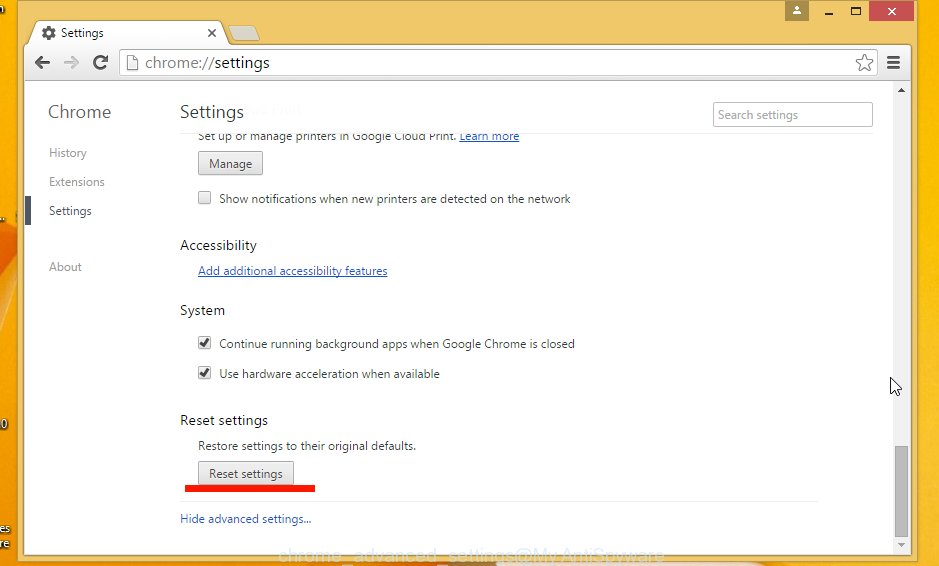
Confirm your action, press the “Reset” button.
Remove NetSurf ads from IE
First, start the Internet Explorer, then click ![]() button. Next, press “Internet Options” like below.
button. Next, press “Internet Options” like below.

In the “Internet Options” screen select the Advanced tab. Next, press the “Reset” button. The Internet Explorer will display the “Reset Internet Explorer” settings dialog box. Select the “Delete personal settings” check box and click Reset button.

You will now need to reboot your system for the changes to take effect. It will restore the IE’s settings like startpage, new tab page and default search engine to default state, disable ad-supported web-browser’s extensions and thereby get rid of the annoying NetSurf pop-up ads.
Disinfect the browser’s shortcuts to remove NetSurf redirects
When the ‘ad supported’ software is started, it can also modify the browser’s shortcuts, adding an argument similar “http://site.address” into the Target field. Due to this, every time you start the browser, it will be redirected to an unwanted ads.
To clear the browser shortcut, right-click to it and select Properties. On the Shortcut tab, locate the Target field. Click inside, you will see a vertical line – arrow pointer, move it (using -> arrow key on your keyboard) to the right as possible. You will see a text which begins with “http://” which has been added here. You need to remove it.

When the argument is removed, press the OK button. You need to clean all shortcuts of all your browsers, as they may be infected too.
Delete unwanted Scheduled Tasks
Once installed, the adware can add a task in to the Windows Task Scheduler Library. Due to this, every time when you run your PC system, it will display an unwanted ad page. So, you need to check the Task Scheduler Library and get rid of all tasks that have been created by adware.
Press Windows and R keys on your keyboard together. It will open a prompt which titled with Run. In the text field, type “taskschd.msc” (without the quotes) and click OK. Task Scheduler window opens. In the left-hand side, press “Task Scheduler Library”, like below.
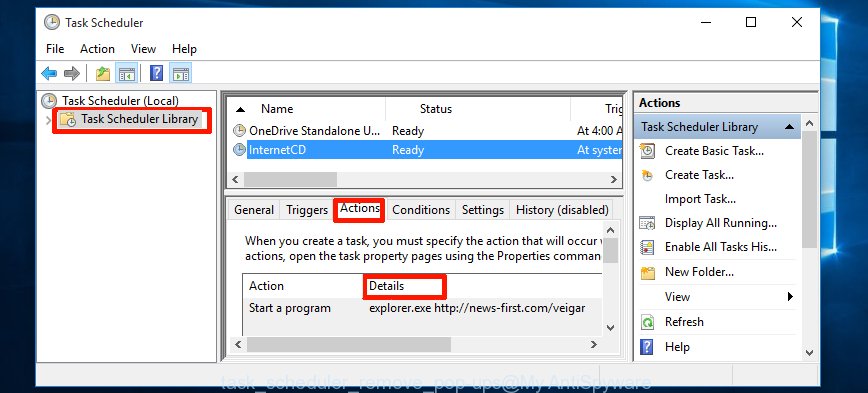
Task scheduler, list of tasks
In the middle part you will see a list of installed tasks. Select the first task, its properties will be open just below automatically. Next, click the Actions tab. Necessary to look at the text which is written under Details. Found something such as “explorer.exe http://site.address” or “chrome.exe http://site.address” or “firefox.exe http://site.address”, then you need delete this task. If you are not sure that executes the task, then google it. If it’s a component of the adware, then this task also should be removed.
Further click on it with the right mouse button and select Delete as on the image below.

Task scheduler, delete a task
Repeat this step, if you have found a few tasks that have been created by adware. Once is complete, close the Task Scheduler window.
How to remove NetSurf automatically
Manual removal is not always as effective as you might think. Often, even the most experienced users can not completely get rid of NetSurf adware from the infected computer. This is because the adware can hide its components which are difficult for you to find out and get rid of completely. This may lead to the fact that after some time, the adware again infect your computer and it will begin to show annoying NetSurf pop-ups. Moreover, I want to note that it is not always safe to delete adware manually, if you do not have much experience in setting up and configuring the personal computer.
I suggest using the Malwarebytes Free that are completely clean your personal computer. It’s an advanced malware removal program developed by (c) Malwarebytes lab. This program uses the world’s most popular anti-malware technology. It is able to help you remove browser hijackers, malware, ad supported software, toolbars, ransomware and other security threats from your PC for free.
Now, click the link below to download Malwarebytes Free on your computer. Save it on your Windows desktop or in any other place.
327002 downloads
Author: Malwarebytes
Category: Security tools
Update: April 15, 2020
After downloading is complete, close all applications on your computer. Next, run the setup file named mb3-setup. If the “User Account Control” dialog box pops up as shown on the screen below, press the Yes button.

It will open the “Setup wizard” that will help you install Malwarebytes on your machine. Follow the prompts and don’t make any changes to default settings.

Once installation is done successfully, click Finish button. Then Malwarebytes will automatically start and you can see its main screen as shown below.
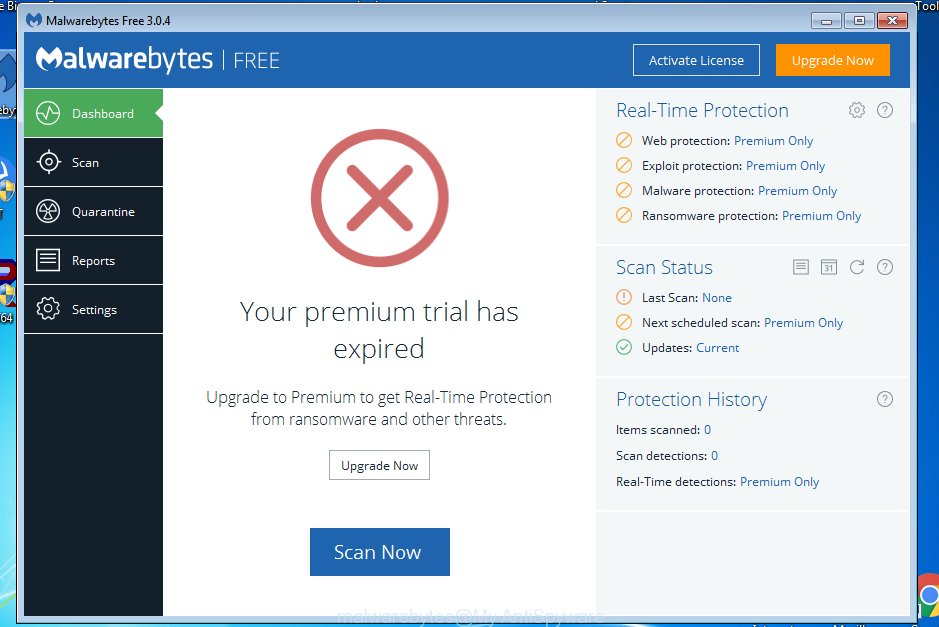
Now click the “Scan Now” button for checking your PC for the NetSurf adware and other malware. Once the ad supported software or malware is found, the number of the detected objects will change accordingly. Wait until the the checking is complete. Please be patient.
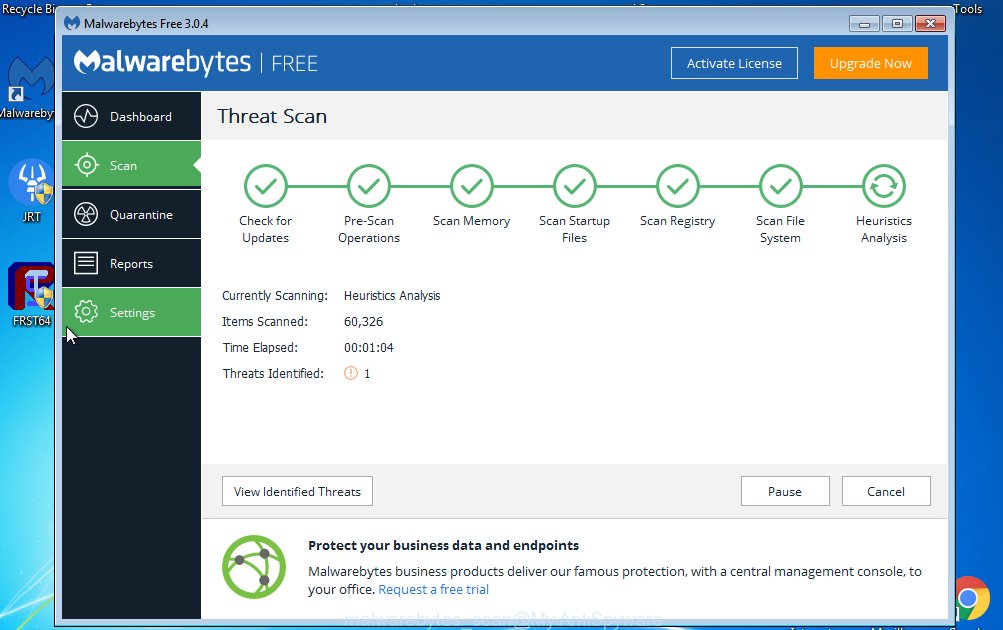
When it has finished scanning, you can check all threats detected on your PC system. Make sure all entries have “checkmark” and click “Quarantine Selected” button. The Malwarebytes will begin removing malware and adware. Once disinfection is done, you may be prompted to reboot your PC.
I suggest you look at the following video, which completely explains the procedure of using the Malwarebytes application to delete adware and other malware.
Stop NetSurf redirects and other unwanted web pages
To increase your security and protect your PC against new annoying ads and malicious pages, you need to use program that stops access to dangerous advertisements and sites. Moreover, the program can stop the show of intrusive advertising, that also leads to faster loading of web pages and reduce the consumption of web traffic.
Download AdGuard program from the following link.
26826 downloads
Version: 6.4
Author: © Adguard
Category: Security tools
Update: November 15, 2018
Once downloading is finished, start the file named adguardInstaller. You will see the “Setup Wizard” screen as shown in the figure below.

Follow the prompts. Once the setup is finished, you will see a window like below.

You can click “Skip” to close the installation program and use the default settings, or press “Get Started” button to see an quick tutorial which will allow you get to know AdGuard better.
In most cases, the default settings are enough and you do not need to change anything. Each time, when you launch your personal computer, AdGuard will start automatically and block popup ads, NetSurf redirects, as well as other malicious or misleading web-pages. For an overview of all the features of the program, or to change its settings you can simply double-click on the AdGuard icon, which is located on your Windows desktop.
Delete NetSurf pop-up ads and malicious extensions with AdwCleaner.
If MalwareBytes cannot remove the unwanted NetSurf ads from the Google Chrome, Internet Explorer, Firefox and Microsoft Edge, then we suggests to use the AdwCleaner. AdwCleaner is a free removal tool for ‘ad supported’ software, browser hijackers, PUPs and toolbars.
Download AdwCleaner from the link below.
225513 downloads
Version: 8.4.1
Author: Xplode, MalwareBytes
Category: Security tools
Update: October 5, 2024
After the download is done, open the directory in which you saved it. Double click the AdwCleaner icon. Once this tool is launched, you will see a screen such as below.

Now, click the “Scan” button for scanning your system for the malicious extensions and NetSurf adware. Once the scanning is complete, it will display a scan report as shown below.
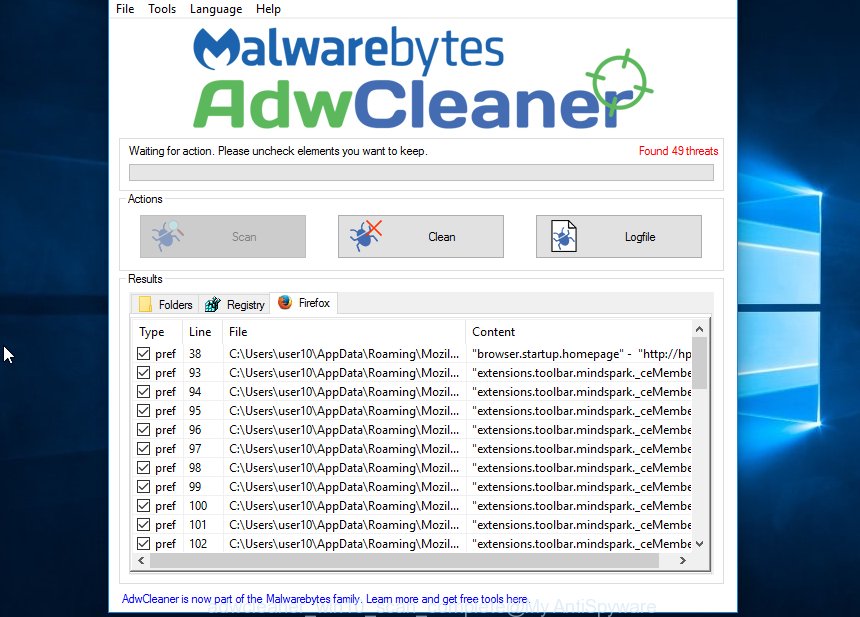
Review the report and then click “Clean” button. It will show a prompt. Click “OK”. Once the cleaning procedure is done, AdwCleaner may ask you to reboot your machine.
Look at the following video, which completely explains the procedure of using the AdwCleaner to delete adware, browser hijackers and other malicious programs.
Finish words
Once you have done the guide shown above, your system should be clean from malware and NetSurf software. The Chrome, Firefox, Microsoft Internet Explorer and Edge will no longer show annoying pop-up ads or redirect you to unwanted web pages. Unfortunately, if the guide does not help you, then you have caught a new type of adware, and then the best way – ask for help in our Spyware/Malware removal forum.



















